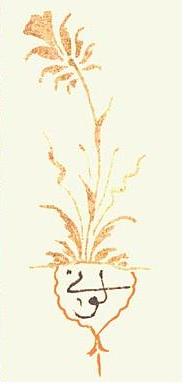Abdulcelil Levni

Levnî Abdülcelil Çelebi (1680s-1732) was an early 18th century Ottoman court painter under Sultans Mustafa II and Ahmed III. He was a prominent Ottoman miniaturist during the Tulip Period, well-regarded for his traditional yet innovative style.
Biography[]
Levnî Abdülcelil Çelebi was borne in Edirne and most likely belonged to a high class family in the empire because his surname, Çelebi, is a title meaning "gentleman".[1]
Levnî began his work in Istanbul during Sultan Mustafa II's rule and eventually became chief painter at the palace atelier.[2] During his stay at the palace, he specialized in the SaZ style, which is characterized by stylized leaf designs.[2] In spite of his high artist status, his name does not appear on lists of artists working for the palace during his time.[2] However, his signed artworks and influence on subsequent artists are evidences that he was an important artist of his time.[2] Levnî died in Istanbul during the early 18th century.[1]
Notable works[]
Levnî's most notable works include the Kebir Musavver Silsilename in Topkapi Palace Library (A3109), Surname-i Vehbi ("Book of Festivals") in the Library of Ahmed II in Topkapi Palace Museum, and an Album of miniatures at the Topkapi Palace Library.[1]
Kebir Musaver Silsilmane, Topkapi Palace Museum Library (A3109)[]

Also known as the Series of Sultan Portraits, this work contains twenty-three padishas, including portraits of Sultan Mahmud I, Sultan Osman III, Sultan Mustafa III, and Sultan Abdulhamid I.[1] Gathering influence from western styles, particularly portraiture of Rafael, Levnî created a genealogical tree of the Sultans using images instead of text like traditional padishas.[1]
Levnî's signature style in this work is evident in the size and color of the portraits in the book. [1] His portraits are large (14.3 cm x 23.5 cm x 16.4 cm x 25 cm), and the subjects are turned 3/4 to the right or left of the view of the viewer.[2] Additionally, he used a wide range of colors, both bright primary and pastel tones.[1][2] His combination of color palettes was innovative for its time and gave way to a new style of Ottoman miniature art.[1]

Surname-i Vebbi[]
The Surname-i Vebbi is a ceremony book containing a series of miniatures depicting scenes from the circumcision of the sons of the Sultan in 1720.[3] The event was celebrated for fifteen days and fifteen nights and involved a courtly processions. Levnî was comissioned by Seyyd Hüseyin Vehbi to record the event in manuscript form.[3] The miniatures in the Surname-i Vebbi are elaborate , capturing varying angles of movement in a wide range of colors and shapes.[3] There is also evidence of the Persian influence in the paintings some examples of which are the cultural objects in the background and the attire of some of the figures.[1][3]

Album Paintings[]


The Album paintings captures daily life in the Ottoman empire during the Tulip period.[1][2] In it, Levnî painted portraits of various people of both noble and common backgrounds in different poses and doing everyday activities.[2] Each image is separated form the others and has its own color composition and subject matter.[1][2] The styles of attire, fabric patterns and the type of activities reflect the finery and richness of the Tulip Period.[3]
Other Works[]
Levni was also a notable poet and wrote on the subjects of heroism and war and daily life in the Ottoman empire.[2] Some of his work are found in the poetry manuscript (Mecmua-i Es'ar, H1715) in the Treasure Library of Topkapi Palace Museum Library.[2][3] Like his paintings, Levnî combined traditional styles of courts, particularly the , as well as humor and popular language of the people in his poetry.[2]
Examples of Levnî's miniatures[]
See also[]
References[]
- ^ Jump up to: a b c d e f g h i j k Şeyhun, Melis H. (19 December 2003). Two perspectives on the tulip era: a collection of works from Rijksmuseum and Topkapı Palace Museum : Vanmour and Levnî : Topkapı Palace Museum,. Istanbul: Topkapı Palace Museum: translators: Reyhan Alp, Linda Stark. pp. 73–101. ISBN 975296057X.
- ^ Jump up to: a b c d e f g h i j k l İrepoğlu, Gül, and Levnî (1999). Levni: painting, poetry, color. Istanbul. Istanbul: Society of Friends of Topkapı Palace Museum. pp. 5–185. ISBN 975-7510-05-X.
- ^ Jump up to: a b c d e f Atıl, Esin, Seyyit Vehbî, and Levni. (1999). Levni and the Surname: the story of an eighteenth-century Ottoman festival. Istanbul: Kocbank. pp. 180–200. ISBN 975-6845-03-1.
External links[]
![]() Media related to Abdulcelil Levni at Wikimedia Commons
Media related to Abdulcelil Levni at Wikimedia Commons
- 1732 deaths
- Miniaturists of the Ottoman Empire
- People from Edirne
- 18th-century artists of the Ottoman Empire
- 18th-century painters of the Ottoman Empire
- People of the Ottoman Empire stubs
- Turkish people stubs
- Asian painter stubs
- European painter stubs









